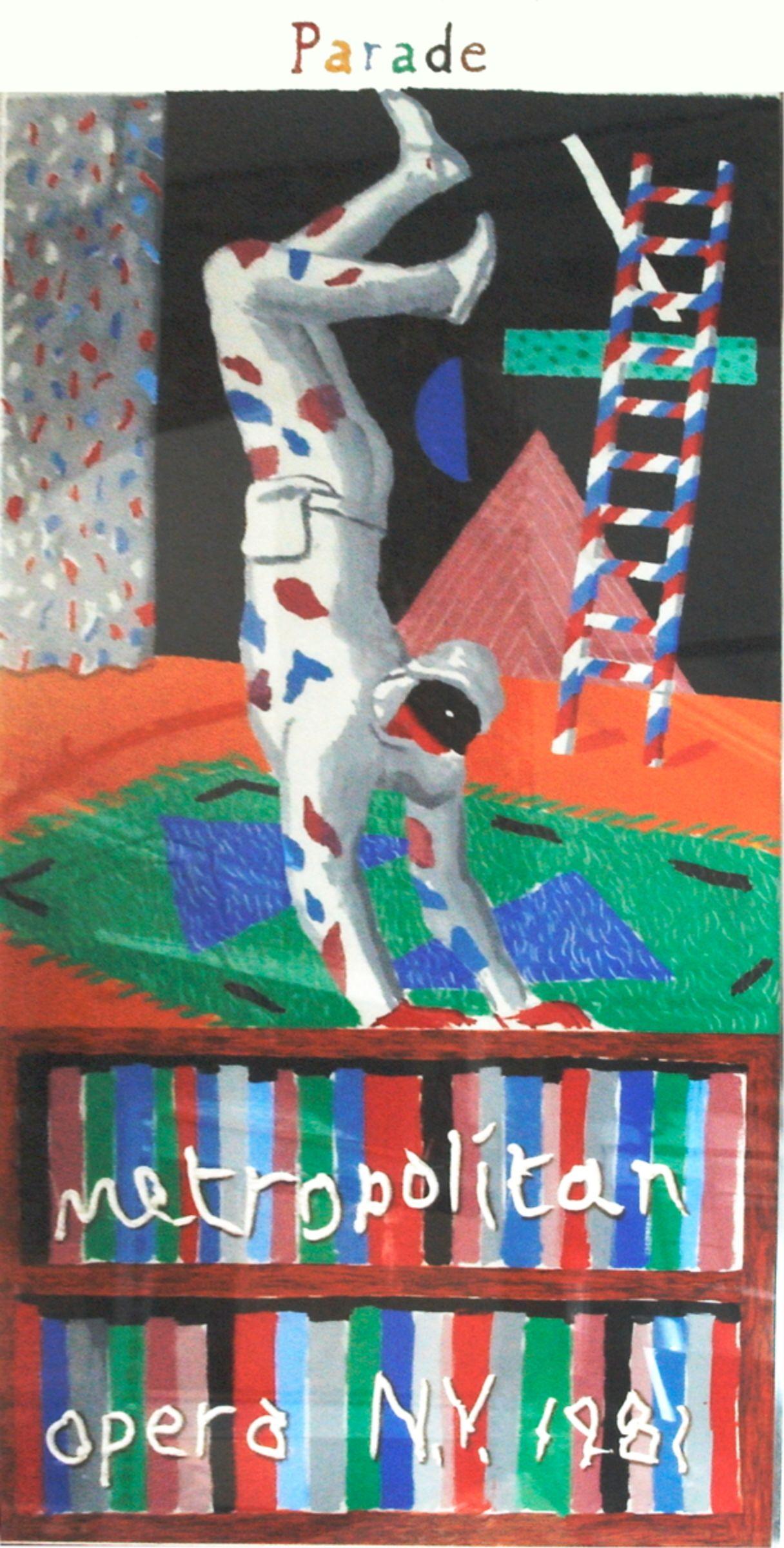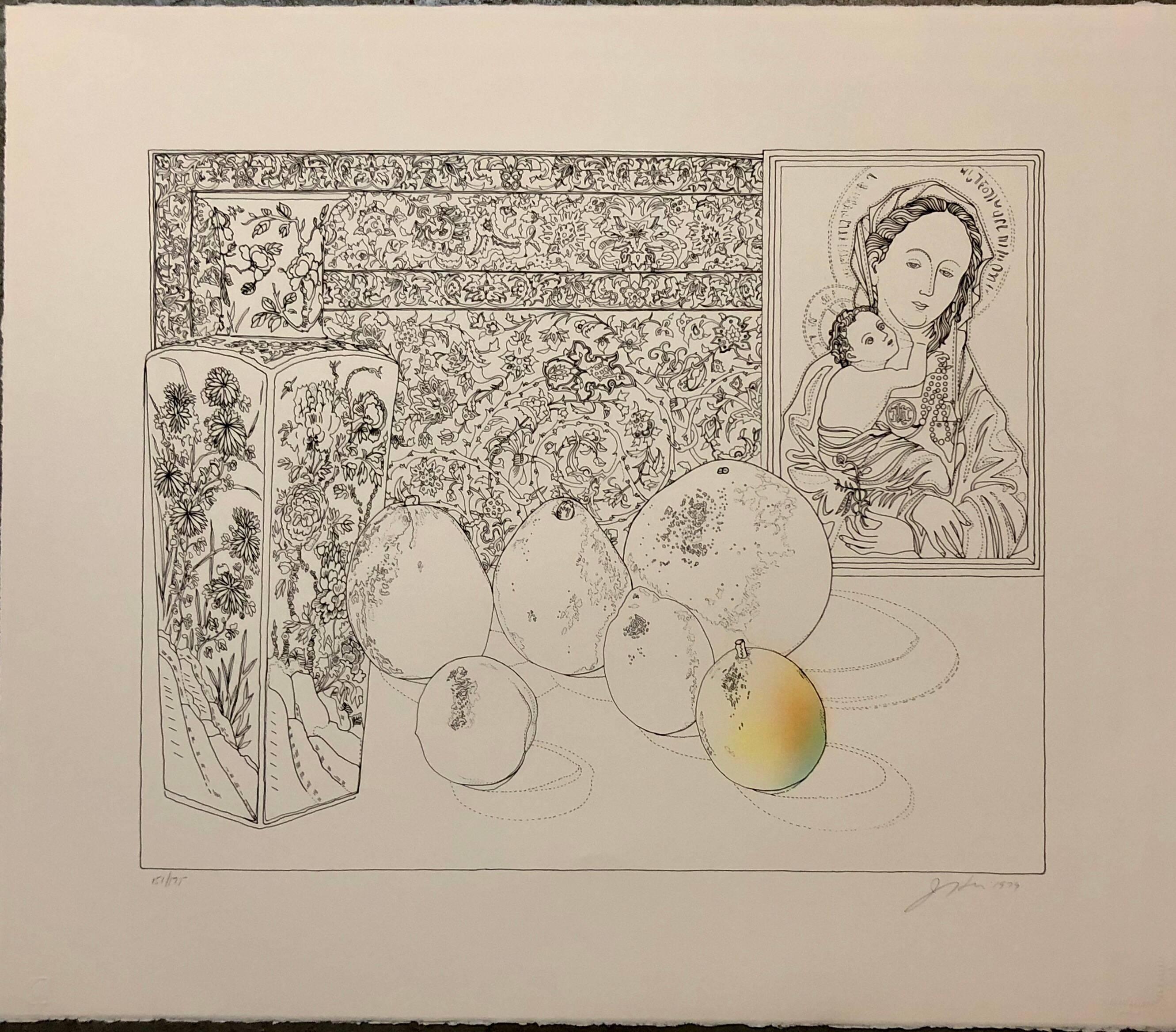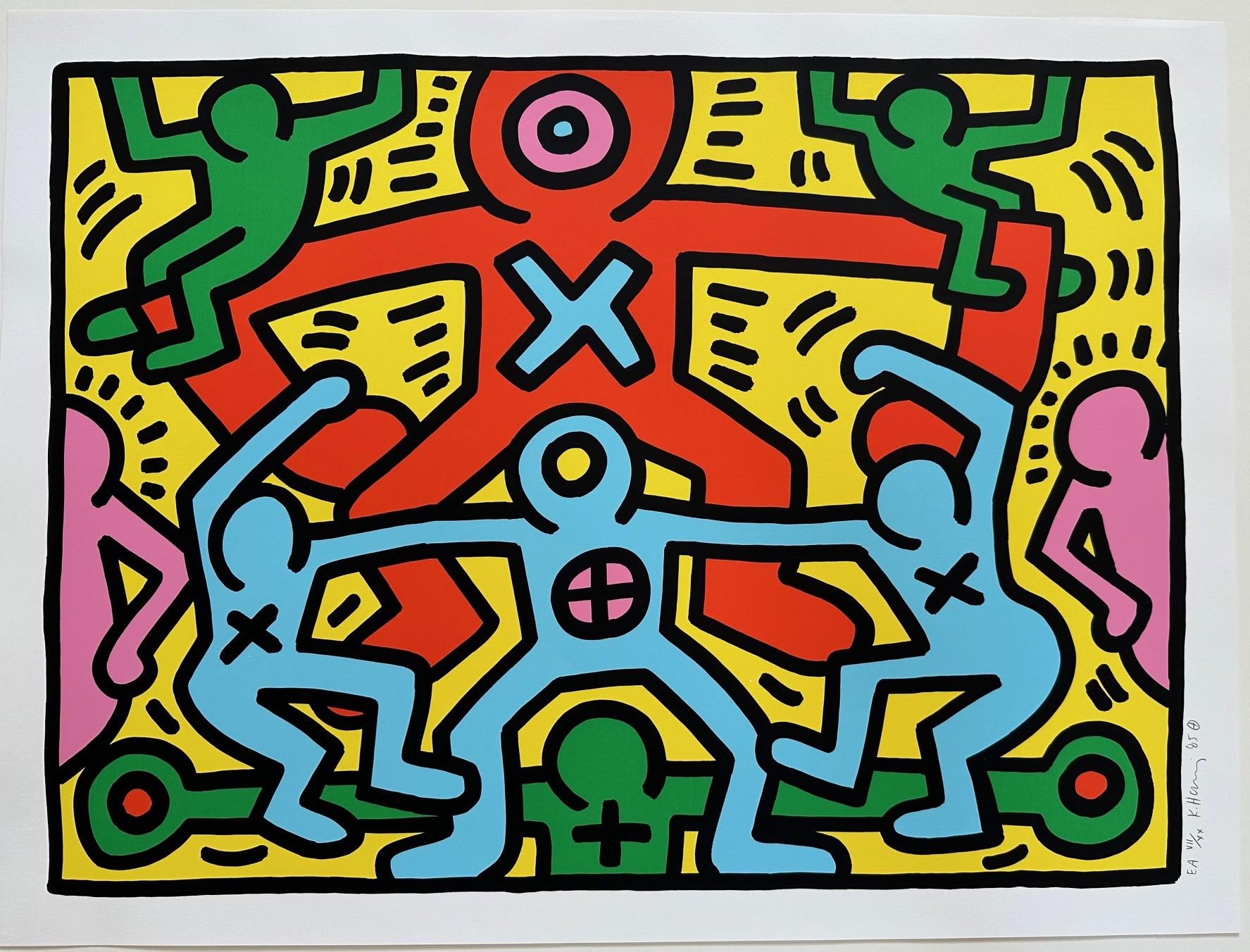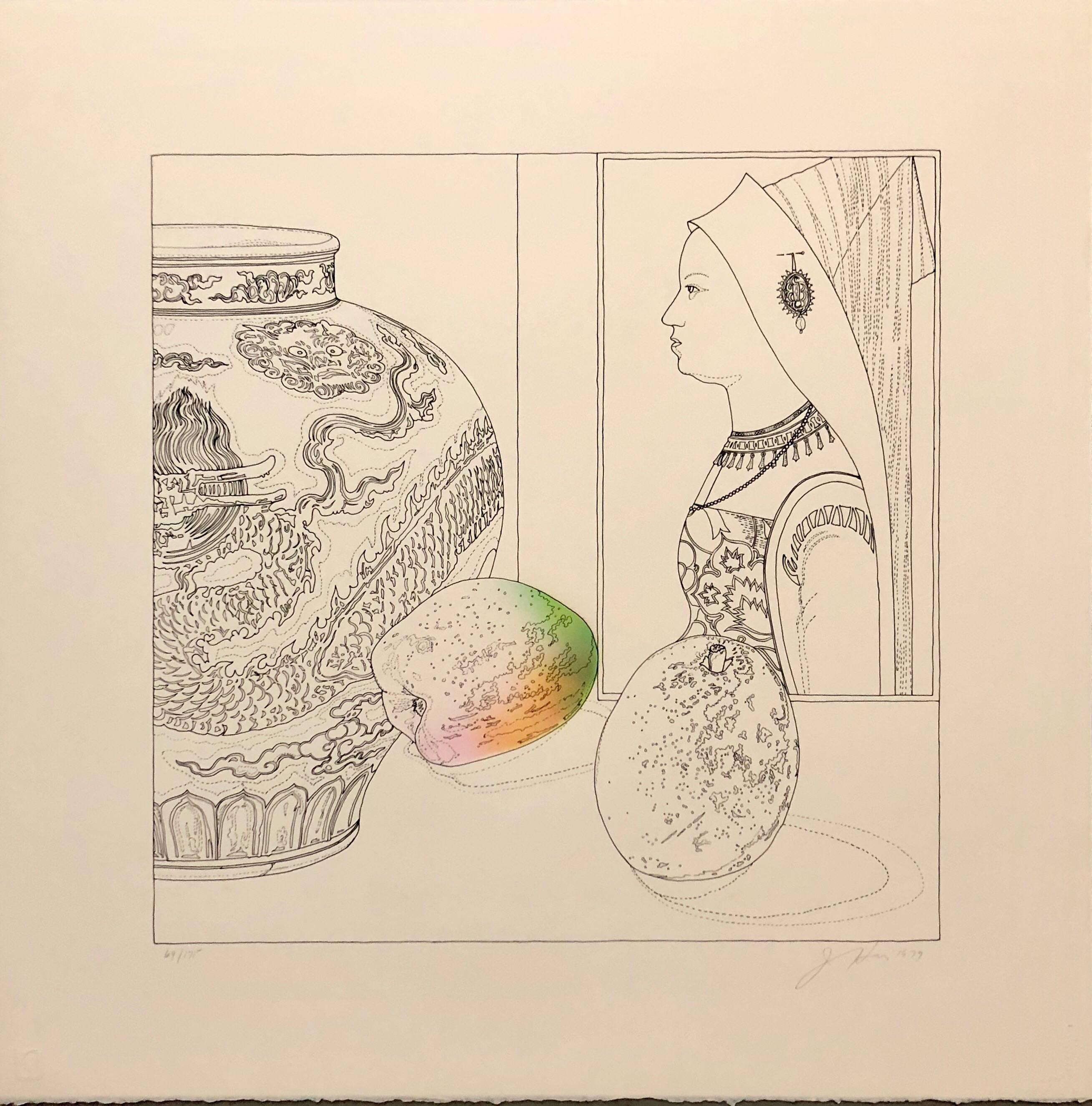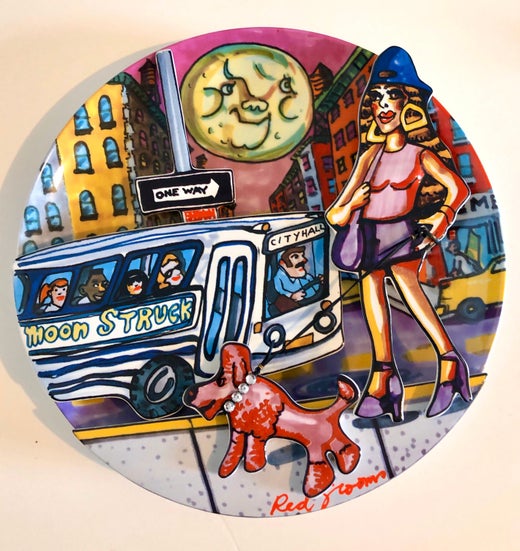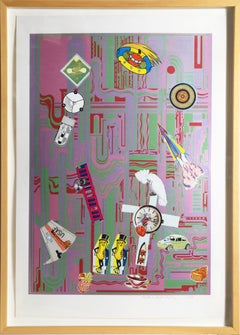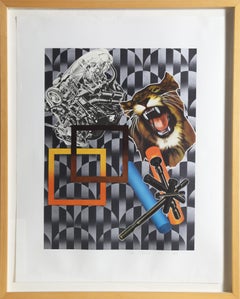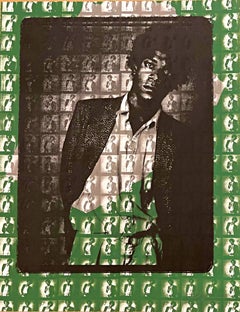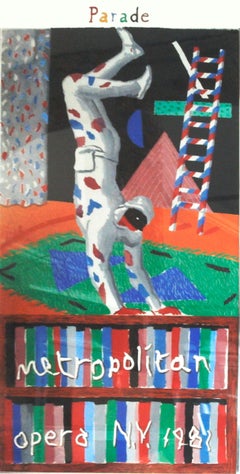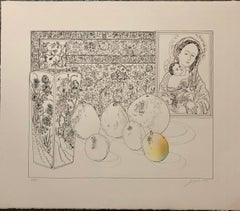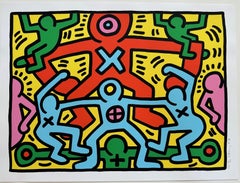Items Similar to You can have a body like mine!, Pop Art Screenprint by Red Grooms
Want more images or videos?
Request additional images or videos from the seller
1 of 5
Red GroomsYou can have a body like mine!, Pop Art Screenprint by Red Grooms1978
1978
About the Item
You Can Have a Body Like Mine!
Red Grooms, American (1937)
Date: 1978
Screenprint, signed and numbered in pencil
Edition of 85/150
Image Size: 24 x 17.75 inches
Size: 31 x 25 in. (78.74 x 63.5 cm)
Frame Size: 34 x 28 inches
Reference: Fig. no. 70 in "Red Grooms: The Graphic Work" published by Harry Abrams, Inc 2001
- Creator:Red Grooms (1937, American)
- Creation Year:1978
- Dimensions:Height: 34 in (86.36 cm)Width: 28 in (71.12 cm)
- Medium:
- Movement & Style:
- Period:
- Condition:
- Gallery Location:Long Island City, NY
- Reference Number:1stDibs: LU4661726013
Red Grooms
Charles Roger Grooms was born in 1937 in Nashville, Tennessee, a city that, with its lively honky-tonk scene and the theatricality of the historic Grand Ole Opry, would later influence much of his work. Nicknamed for his ginger hair, Red enrolled at the Art Institute of Chicago in 1955. A self-proclaimed “restless and undisciplined student,” Grooms spent the next few years moving between schools and cities, including the New School in New York, Peabody College (now part of Vanderbilt University) in Nashville, and Hans Hofmann’s summer school in Provincetown, Massachusetts. Frustrated with the academic track and anxious to enter the New York art scene, Grooms abandoned formal education to focus exclusively on creating art and securing exhibition opportunities in his Chelsea neighborhood. There, he found quick success and a supportive circle of artists that became close friends and collaborators. From the start of his career, Grooms has worked in multiple media, from painting, printmaking, and sculpture, to installation art, filmmaking, and theatrical experiences known as “Happenings.” Much of his art blurs the boundaries between these different forms, such as his large-scale, carefully-crafted environments he calls “sculpto-pictoramas,” and smaller objects like Dalí Salad. In this example, Grooms combines silkscreened and lithographic elements with a wooden base and acrylic dome to create a three-dimensional portrait of the famous Surrealist artist. Grooms is perhaps best known for his colorful and comedic commentary on the culture, politics, and figures associated with the American urban environment and art historical traditions. Relying on satire and caricature, Grooms’ art has paid homage to a wide range of artists including Rembrandt, Auguste Rodin, Thomas Eakins, and Benjamin West, as well as national icons like Thomas Jefferson and Chuck Berry. Grooms’ disparate output is so difficult to classify that he has been compared to the influential Dada artist, Marcel Duchamp. Like Duchamp, Grooms often deliberately confronts the art world establishment, noting in 1974 that “it’s good to have . . . something to go against.” Despite his affinity for defying the mainstream, Grooms is routinely cited by scholars as one of the leading American artists of his generation and was honored with the National Academy of Design’s Lifetime Achievement Award in 2003. The subject of a 1984 mid-career retrospective exhibition held at the Pennsylvania Academy of the Fine Arts, the artist’s work can be found in public collections across the United States, including the Metropolitan Museum of Art, the Whitney Museum of American Art, and the Hirshhorn Museum and Sculpture Garden, as well as in many international museums. - The Johnson Collection, Spartanburg, South Carolina
About the Seller
4.9
Platinum Seller
Premium sellers with a 4.7+ rating and 24-hour response times
Established in 1979
1stDibs seller since 2014
2,969 sales on 1stDibs
Typical response time: 1 hour
- ShippingRetrieving quote...Shipping from: Long Island City, NY
- Return Policy
Authenticity Guarantee
In the unlikely event there’s an issue with an item’s authenticity, contact us within 1 year for a full refund. DetailsMoney-Back Guarantee
If your item is not as described, is damaged in transit, or does not arrive, contact us within 7 days for a full refund. Details24-Hour Cancellation
You have a 24-hour grace period in which to reconsider your purchase, with no questions asked.Vetted Professional Sellers
Our world-class sellers must adhere to strict standards for service and quality, maintaining the integrity of our listings.Price-Match Guarantee
If you find that a seller listed the same item for a lower price elsewhere, we’ll match it.Trusted Global Delivery
Our best-in-class carrier network provides specialized shipping options worldwide, including custom delivery.More From This Seller
View AllOmaggio a Marilyn (A Tribute to Marilyn), Pop Art Screenprint by Mimmo Rotella
By Mimmo Rotella
Located in Long Island City, NY
Artist: Mimmo Rotella, Italian (1918 - 2006)
Title: Omaggio a Marilyn
Year: 2004
Medium: Serigraph with collage, signed and numbered in pencil
Edition: PA
Size: 38 x 28 inches
Category
Early 2000s Pop Art Figurative Prints
Materials
Screen
Jazz Band, Signed Pop Art Screenprint by Burton Morris
By Burton Morris
Located in Long Island City, NY
Artist: Burton Morris
Title: Jazz Band
Year: 1998
Medium: Screenprint, signed and numbered in pencil
Edition: PP 4/5
Image Size: 25.5 x 34 inches
Paper Size: 30 x 39.5 inches
Category
1990s Pop Art Figurative Prints
Materials
Screen
$1,200 Sale Price
20% Off
Mr. Peanut - Pop Art Screenprint by Eduardo Paolozzi
By Eduardo Paolozzi
Located in Long Island City, NY
Artist: Eduardo Paolozzi, British (1924 - 2005)
Title: Mr Peanut
Year: 1970
Medium: Screenprint, signed and dated in pencil
Image: 27 x 19 inches
Frame Size: 35 x 25 inches
Category
1970s Pop Art Figurative Prints
Materials
Screen
Tiger & Engine, Pop Art Screenprint, by Peter Phillips 1971
By Peter Phillips
Located in Long Island City, NY
Tiger & Engine by Peter Phillips, British (1939)
Date: 1971
Lithograph, signed and dated in pencil
Edition: AP VII
Size: 19 x 14.25 in. (48.26 x 36.2 cm)
Frame Size: 28.5 x 23 inches
Category
1970s Pop Art Animal Prints
Materials
Screen
Mr. Chuck Berry, Pop Art Print by Red Grooms
By Red Grooms
Located in Long Island City, NY
Mr. Chuck Berry by Red Grooms, American (1937)
Date: 1978
Screenprint with 3-D "Dancer", signed and numbered in pencil
Edition of 127/150
Image Size: 24 x 18.25 inches
Size: 33 x 26 ...
Category
1970s Pop Art Figurative Prints
Materials
Screen
Smile, Pop Art Screenprint by Kiki Kogelnik
By Kiki Kogelnik
Located in Long Island City, NY
Artist: Kiki Kogelnik, Austrian (1935 - 1997)
Title: Smile
Year: 1980
Medium: Serigraph, signed and numbered in pencil
Edition: 200, AP 35
Image: 33 x 23.5 inches
Size: 35.5 x 26 in....
Category
1980s Pop Art Figurative Prints
Materials
Screen
Price Upon Request
You May Also Like
Jean-Michel Basquiat Silkscreen Monotype UNIQUE hand signed 2X by Richard Corman
By Richard Corman
Located in New York, NY
Richard Corman
Portrait of Jean-Michel Basquiat: Monotype (hand signed twice by Richard Corman), 2015
Silkscreen monotype on 320 gram Coventry Rag paper with deckled edges
Signed twi...
Category
2010s Pop Art Portrait Prints
Materials
Screen, Monotype
Richard CormanJean-Michel Basquiat Silkscreen Monotype UNIQUE hand signed 2X by Richard Corman, 2015
$10,000 Sale Price
33% Off
Harlequin from Parade for the Metropolitan Opera
By David Hockney
Located in Brooklyn, NY
This rare and collectible poster by David Hockney was part of a series of three billboards commissioned by the Metropolitan Opera in New York City in 1981. Designed specifically for ...
Category
1980s Pop Art Figurative Prints
Materials
Screen
$3,600 Sale Price
20% Off
Still Life with German Master Pop Art Serigraph Hand Signed
By Josef Levi
Located in Surfside, FL
On deckle edged watermarked Arches French paper with publishers embossed blindstamp. hand signed in pencil, dated and numbered. the edition size is 175.
there are three states of the same image image each with increasing detail and color.
This auction is just for the one shown in the photos.
Josef Alan Levi (1938) is an American artist whose works range over a number of different styles, but which are unified by certain themes consistently present among them. Josef Levi began his artistic career in the 1960s and early '70s, producing highly abstract and very modernist pieces: these employing exotic materials such as light fixtures and metallic parts. By 1975, Levy had transitioned to painting and drawing still lifes. At first these were, traditionally, of mundane subjects. Later, he would depict images from art history, including figures originally created by the Old Masters. Around 1980, he made another important shift, this time toward creating highly precise, though subtly altered reproductions of pairs of female faces which were originally produced by other artists. It is perhaps this work for which he is most well known. Since around 2000, Josef Levi has changed the style of his work yet again: now he works entirely with computers, using digital techniques to abstract greatly from art history, and also from other sources.
Levi's works of art in the collections of the Museum of Modern Art, NYC, the National Gallery of Art, and the Albright-Knox Museum, among many others. Levi's art has been featured on the cover of Harper's Magazine twice, once in June 1987, and once in May 1997.
Josef Levi received a Bachelor of Arts degree in 1959 from the University of Connecticut, where he majored in fine arts and minored in literature. From 1959 to 1960, he served to a first lieutenant in the U.S. Army, and from 1960 through 1967 he was in the U.S. Army Reserves.
In 1966, he received the Purchase Award from the University of Illinois in 1966, and he was featured in New Talent U.S.A. by Art in America. He was an artist in residence at Appalachian State University in 1969, taught at Farleigh Dickenson University in 1971 and was a visiting professor of art at Pennsylvania State University in 1977. From 1975 to 2007, Levi resided in New York City. He now lives in an apartment in Rome, where he is able to paint with natural light as he was unable in New York.
From 1959 to 1960, Josef took some courses of Howard McParlin Davis and Meyer Schapiro at Columbia University which initiated him into the techniques of reproducing the works of the Old Masters. His first works, created in the 1960s, were wood and stone sculptures of women. His first mature works were abstract pieces, constructed of electric lights and steel.
In 1970, Levi's materials included fluorescent light bulbs, Rust-Oleum and perforated metal in addition to paint and canvas.
By 1980, Josef Levi's art had transformed into a very specific form: a combination of reproductions of female faces which were originally depicted by other artists. The faces which he reproduces may be derived from either portraits or from small portions of much larger works; they are taken from paintings of the Old Masters, Japanese ukiyo-e, and 20th-century art. Artists from whom he has borrowed include: Vermeer, Rembrandt, Piero della Francesca, Botero, Matisse, Utamaro, Correggio, Da Vinci, Picasso, Chuck Close, Max Beckmann, Pisanello, Lichtenstein. The creation of these works is informed by Levi's knowledge and study of art history.
Josef Levi's paintings from this period are drawn, then painted on fine linen canvas on wooden stretchers. The canvas is coated with twenty-five layers of gesso in order to produce a smooth surface on which to work. The drawing phase takes at least one month. Levi seals the drawing with acrylic varnish, and then he may apply layers of transparent acrylic in order to approximate the look of old paintings. After the last paint is applied, another layer of acrylic varnish is sprayed on to protect the work.
Most of the figures in his contemporary pieces are not paired with any others.
SELECTED COLLECTIONS
MUSEUM OF MODERN ART, NEW YORK, NY
ALBRIGHT- KNOX GALLERY, BUFFALO, NY
ALDRICH MUSEUM OF CONTEMPORARY ART, RIDGEFIELD, CT
NATIONAL GALLERY OF ART, WASHINGTON, DC
BROOKLYN MUSEUM OF ART, BROOKLYN, NY
SMITHSONIAN NATIONAL MUSEUM OF AMERICAN HISTORY, WASHINGTON, DC
CORCORAN GALLERY, WASHINGTON, DC
UNIVERSITY OF NOTRE DAME ART...
Category
1970s Pop Art Figurative Prints
Materials
Lithograph, Screen
Untitled Littmann 50
By Keith Haring
Located in Miami, FL
EA Artists Proof aside from edtion of 150. Screenprint in colors on Wove Paper.
Hand signed, numbered from the Artists Proof edition of 20 and dated '85 in pencil right side margin. Published by Martin Lawrence Limited Editions, Inc., New York...
Category
1980s Pop Art Figurative Prints
Materials
Screen
Mini Fab - Pride, Limited edition print, Hand made print, Ice cream Art
By Gavin Dobson
Located in Deddington, GB
To celebrate 50 golden years of Pride UK. A special golden disco mix edition of one of my most popular pieces. 5 layer screen print on Heritage white. A celebration of colour and par...
Category
2010s Pop Art More Prints
Materials
Paper, Glitter, Mixed Media, Screen
Still Life with Hans Maler Pop Art Serigraph Hand Signed
By Josef Levi
Located in Surfside, FL
On deckle edged watermarked Arches French paper. hand signed in pencil, dated and numbered. the edition size is 175.
there are three states of the same image image each with increasing detail and color. This is just for the one in the photo.
Josef Alan Levi (1938) is an American artist whose works range over a number of different styles, but which are unified by certain themes consistently present among them. Josef Levi began his artistic career in the 1960s and early '70s, producing highly abstract and very modernist pieces: these employing exotic materials such as light fixtures and metallic parts. By 1975, Levy had transitioned to painting and drawing still lifes. At first these were, traditionally, of mundane subjects. Later, he would depict images from art history, including figures originally created by the Old Masters. Around 1980, he made another important shift, this time toward creating highly precise, though subtly altered reproductions of pairs of female faces which were originally produced by other artists. It is perhaps this work for which he is most well known. Since around 2000, Josef Levi has changed the style of his work yet again: now he works entirely with computers, using digital techniques to abstract greatly from art history, and also from other sources.
Levi's works of art in the collections of the Museum of Modern Art, NYC, the National Gallery of Art, and the Albright-Knox Museum, among many others. Levi's art has been featured on the cover of Harper's Magazine twice, once in June 1987, and once in May 1997.
Josef Levi received a Bachelor of Arts degree in 1959 from the University of Connecticut, where he majored in fine arts and minored in literature. From 1959 to 1960, he served to a first lieutenant in the U.S. Army, and from 1960 through 1967 he was in the U.S. Army Reserves.
In 1966, he received the Purchase Award from the University of Illinois in 1966, and he was featured in New Talent U.S.A. by Art in America. He was an artist in residence at Appalachian State University in 1969, taught at Farleigh Dickenson University in 1971 and was a visiting professor of art at Pennsylvania State University in 1977. From 1975 to 2007, Levi resided in New York City. He now lives in an apartment in Rome, where he is able to paint with natural light as he was unable in New York.
From 1959 to 1960, Josef took some courses of Howard McParlin Davis and Meyer Schapiro at Columbia University which initiated him into the techniques of reproducing the works of the Old Masters. His first works, created in the 1960s, were wood and stone sculptures of women. His first mature works were abstract pieces, constructed of electric lights and steel.
In 1970, Levi's materials included fluorescent light bulbs, Rust-Oleum and perforated metal in addition to paint and canvas.
By 1980, Josef Levi's art had transformed into a very specific form: a combination of reproductions of female faces which were originally depicted by other artists. The faces which he reproduces may be derived from either portraits or from small portions of much larger works; they are taken from paintings of the Old Masters, Japanese ukiyo-e, and 20th-century art. Artists from whom he has borrowed include: Vermeer, Rembrandt, Piero della Francesca, Botero, Matisse, Utamaro, Correggio, Da Vinci, Picasso, Chuck Close, Max Beckmann, Pisanello, Lichtenstein. The creation of these works is informed by Levi's knowledge and study of art history.
Josef Levi's paintings from this period are drawn, then painted on fine linen canvas on wooden stretchers. The canvas is coated with twenty-five layers of gesso in order to produce a smooth surface on which to work. The drawing phase takes at least one month. Levi seals the drawing with acrylic varnish, and then he may apply layers of transparent acrylic in order to approximate the look of old paintings. After the last paint is applied, another layer of acrylic varnish is sprayed on to protect the work.
Most of the figures in his contemporary pieces are not paired with any others.
SELECTED COLLECTIONS
MUSEUM OF MODERN ART, NEW YORK, NY
ALBRIGHT- KNOX GALLERY, BUFFALO, NY
ALDRICH MUSEUM OF CONTEMPORARY ART, RIDGEFIELD, CT
NATIONAL GALLERY OF ART, WASHINGTON, DC
BROOKLYN MUSEUM OF ART, BROOKLYN, NY
SMITHSONIAN NATIONAL MUSEUM OF AMERICAN HISTORY, WASHINGTON, DC
CORCORAN GALLERY, WASHINGTON, DC
UNIVERSITY OF NOTRE DAME ART...
Category
1970s Pop Art Figurative Prints
Materials
Lithograph, Screen
Recently Viewed
View AllRead More
Red Grooms Salutes the ‘Ninth Street Women’ Who Revolutionized Modern Art
In a new show of peppy portraits, the 85-year-old artist looks back at 1950s New York, when the Abstract Expressionists ruled the scene. Only now, the women Ab-Ex artists get more of the spotlight than the men.
Romare Bearden’s Humanity Infuses His Bright, Bold Art
Through collage, painting and printmaking, the artist foregrounded Black life in America in revolutionary new ways.

